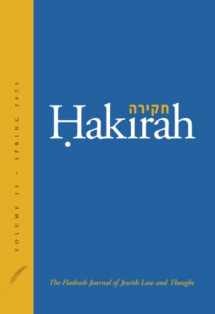
Hakirah: The Flatbush Journal of Jewish Law and Thought (Volume 33)
Book details
Summary
Description
In a lecture series titled “The Relationship between Halakhah, Aggadah, and Kabbalah” delivered at Bernard Revel Graduate School ca. 1950, Rav Yosef B. Soloveitchik, ztz”l, defines these three branches of Torah study, explains their relationship to each other, and sheds light on the religious experience that emerges from their study. In this volume of Ḥakirah, a special section keynoted by these lectures is augmented by additional essays dealing with the relationship between Halakhah, Aggadah, and Kabbalah. An essay titled “‘Truth’ and Authorial Intent in the Study of Torah”shows that some Torah scholars believed that they could interpret the works of earlier rabbis loosely, in a manner not in accord with their author’s intent. An accompanying article titled “Learning” argues that such an approach is not in accord with the mainstream of Halakhic interpretation, bringing evidence from the Rav’s analysis of Halakhah as presented in the above-mentioned lecture series. Another essay on Western philosophy’s sources in the Lurianic Kabbalah reviews a recent book on tsimtsum and shows how Christian thinkers in particular misunderstood the Arizal’s philosophical concept, quoting the following crucial passage from the Rav’s lectures to prove his point: “The Kabbalistic perspective rests on Halakhah. Even theology was Halakhic to the Jewish mystic: his fulcrum is to be found in Halakhic law. The religious commandment was interpreted by the Kabbalistic mystic not allegorically, but as Divine order impregnated with transcendental and cosmic significance and endowed with meaning of cosmic proportions.”
In our Jewish Law section, we deal with matters of increasing contemporary relevance. “Halakhic Approaches to a Man-made Epidemic: Opioids and Narcan” deals with a pressing issue as the use of dangerous drugs has made its way into our communities.In “Examining a Controversial Heter: A Woman Who Converted as an Infant Marrying a Kohen?” the authors explain and provide the sources for a psak of the noted posek Rav Ephraim Greenblatt, z”l. In “‘Are We Your First Choice?’: Is it proper to ask this question to a student applying to a yeshivah/seminary, and must they answer honestly?” the author deals with a common question relevant both to our Torah youth and Torah organizations.
Our Talmud Torah section yields interesting insights from the analysis of two parshiyot in the Torah. “The Geographical Context of Devarim and Its Significance” argues that “establishing the book of Devarim on the ruins of Sodom symbolizes the dichotomy between the culture of Sodom and a society predicated on the precepts of the Torah and dedicated to the pursuit of justice.” And “Did the Israelites Eat Matzah While They Were Slaves?” contends that leḥem oni was not eaten by Jewish slaves in Egypt, and nothing in the Torah implies that they did.
Our Jewish Thought section deals with fundamental issues. In one essay titled “Imitations and Semblances,” the author identifies how several Rishonim, including Rambam and Ralbag, explain the purpose of many mitzvot as directing us to explore the reality of the physical world. A review of Strauss, Spinoza and Sinai: Orthodox Judaism and Modern Questions of Faith introduces us to a new work composed of essays by modern Jewish writers dealing with faith. Closing out this section is a hesped by Rav Soloveitchik of an outstanding European Chassidic Rosh Yeshivah who taught Torah in America for almost 50 years. Here the Rav gives us insight into the nature of our ba’alei mesorah.


We would LOVE it if you could help us and other readers by reviewing the book
Book review



